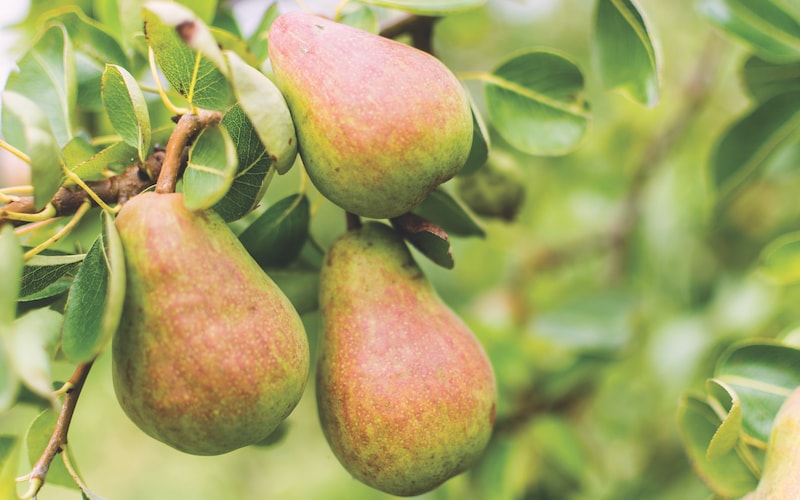Pears are one of the easiest fruits to grow, making them an ideal fruit tree for beginners. What’s more, growing your own pear trees means you can enjoy varieties you wouldn’t normally find in the supermarket.
To make things even easier, we’ve gathered expert advice and top tips from our favourite independent gardening bloggers, YouTubers and Instagrammers. Follow their recommendations and you’ll soon be harvesting plump, juicy pears from your own patio, garden or allotment.
Contents
- Best pear varieties to grow
- Best advice on how to plant your pear tree
- Best advice on how to prune your pear tree
- Best advice on pear tree pests and diseases
- Best advice on how to harvest your pears
Best pear varieties to grow
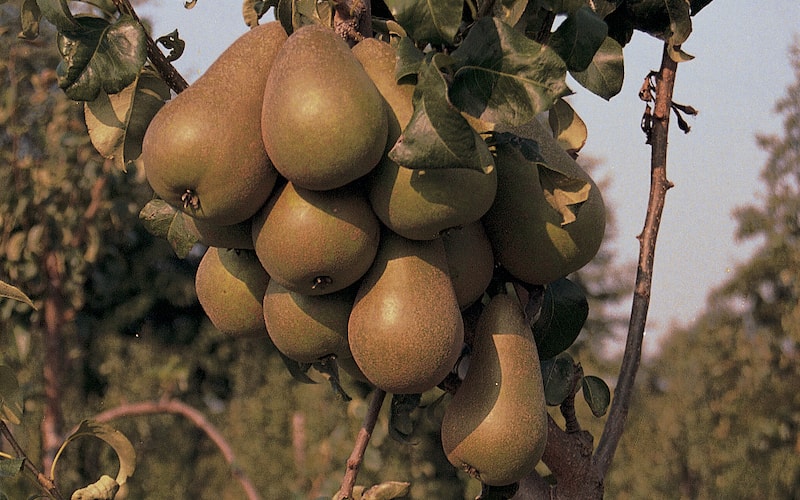
Image: Pear ‘Concorde’ from Suttons
Pear trees can be grown in a number of ways, as our expert gardening team here at Suttons explains in their article on how to grow pear trees. It’s important to “choose the type of tree best suited to your preferred growing technique.” If planting in the ground, choose a more vigorous rootstock such as Quince A. Where smaller trees are required for growing in containers or as cordons, however, Quince C rootstock is best.
Dwarfing varieties can be very compact indeed, as Joanne over at @the_purple_allotment reveals. Take a look at her charming Instagram post showing the ducks at her allotment sheltering under her dwarf pear tree. The little tree clearly loves the sunshine and is in full blossom in mid-April.
Rose Titchiner of @flamedancingrose reports a good year for her ‘Conference’ pear trees, which “are laden, despite the drought”. She grows her fruit trees in containers, buying patio-sized varieties to make the most of the space she has available. The trees also “do pretty well… in my veg beds” and Rose has plans to add more apple trees and perhaps a peach tree to her already impressive garden. Follow her on Instagram to find out what else she grows.
Stephen and Julia Hayes of Fruitwise Heritage Apples like to grow ‘Concorde’ pears – a delicious cross between ‘Conference’ and ‘Comice’. “It’s got that delicate rosewater flavour that you get in some of the better pears,” they enthuse. This husband-and-wife team are expert fruit growers and really know their stuff. Watch their full video review of the ‘Concorde’ pear to find out why you should try this special variety.
Over at @pepgrows, urban gardener Peppe shares a photo of a perfect ‘Comice’ pear grown against a sunny wall at the front of his London home. In fact, he and his wife Serena love growing pear trees in their small garden: “We’re in a British climate where there’s rain and sun during the summer, so why not use that to our advantage? Apples and pears thrive in England.” Read their article to learn their favourite varieties for container growing and pick up some expert tips.
Best advice on how to plant your pear tree
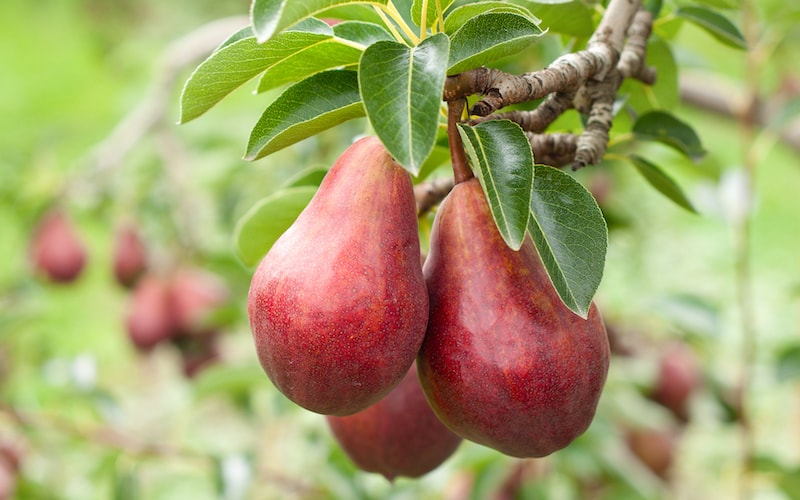
Image: Pear ‘Red William’ from Suttons
Bare root trees are “sold without a pot and delivered while the weather is still cold and the plants are dormant,” explains the team at Grow Veg. This is a great budget-friendly way to grow your own fruit. They recommend that you plant the tree at the same depth as it was first grown in the container by looking for “the slightly darker watermark on the tree’s trunk”. For more advice on how to give bare root trees the best start, watch their full video.
For a straightforward guide to potting on a shop-bought pear tree, watch Peter’s easy-to-follow video over at A Thorny Pot. It’s a job best done in winter, says Peter, when the tree is dormant. His top tip? Use tree and shrub potting mix because “it releases nutrients over a longer period of time, which is ideal for fruit trees.”
Always wanted to grow an espalier fruit tree? Over at Mark’s Garden UK, Mark has trained his pear tree flat against a wall to save space and create “something of interest in the garden”. Watch his informative video on how (and why) to espalier a fruit tree to see how to maintain the tree’s shape. It’s simply a case of removing any new vertical shoots growing off the horizontal branches, he explains.
Pears look great grown as pillar trees, says Instagram gardener @theguillergarden. Growing fruit trees as potted pillars allows gardeners to “control the soil and temperature better”, and these young trees are already producing healthy growth, as you can see in the post. Follow their journey on Instagram to see how this pretty pear tree progresses.
Best advice on how to prune your pear tree

Image: Pear ‘Conference’ from Suttons
Winter is the best time to prune your pear tree if you want to encourage it to produce more fruit the following year, according to Lee Burkhill from Garden Ninja, who approaches the subject with his usual infectious enthusiasm. Pruning is also essential for the plant’s health, stopping it from becoming congested and reducing the risk of disease. Check out Lee’s helpful article and video to pick up useful tips on how to prune a pear tree.
Jonny of Jonny’s Kitchen Garden prunes his pear trees twice a year. Not sure how you’ll know when your trees are ready to prune? Look for woody material at the base of the new shoots, says Jonny, and “if the bottom quarter to a third of the branch is already quite woody, that’s a good sign that these are ready to be pruned.” Watch his video on the three simple rules of summer pruning to find out everything you need to know.
Orchard gardener Paula Fleming had her work cut out reshaping the espaliered pear trees at Le Manoir aux Quat’Saisons, as by mid-June there was “an insane amount of re-growth already”. Although June is not the usual time for pruning, Paula’s outlook is optimistic: “One up-side to this is that I’m inadvertently pruning out a lot of the hail damaged leaves, meaning better photosynthesis, meaning better fed fruit!”
Best advice on pear tree pests and diseases
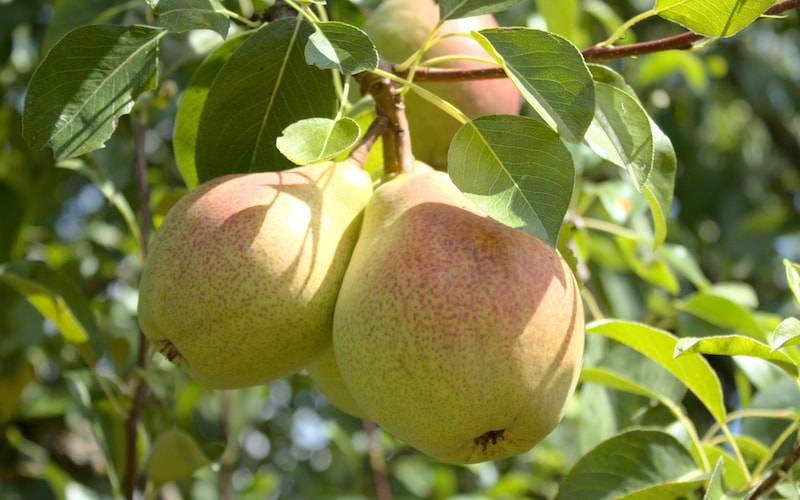
Image: Pear ‘Beurre Hardy’ from Suttons
“Take my advice: if you see signs of disease on a plant, act on it straight away before it gets worse.” Wise words from Sharon of 15 Minutes of Green, who documents her experience of dealing with pear rust, which can lead to reduced cropping if not dealt with early on. Pear rust is often caused by infection on a neighbouring juniper, which harbours the pear rust fungus over winter. Read the full article to find out how Sharon breaks the cycle.
As well as pear rust, Fabraea leaf spot and bacterial fireblight can also affect pear trees, according to the team at Arborcure. Read their helpful article on how to spot and tackle fruit tree diseases to find out what to do and how to halt the spread.
To help prevent disease, keep the grass around your pear trees short so that air can circulate freely, explains Huw Richards of Huw’s Nursery. Huw recommends using a scythe to clear the grass, rather than a strimmer. He says this is less likely to damage the bark, which “can be fatal, especially if it’s a young fruit tree”. Watch his video about scything an orchard to learn more.
Best advice on how to harvest your pears
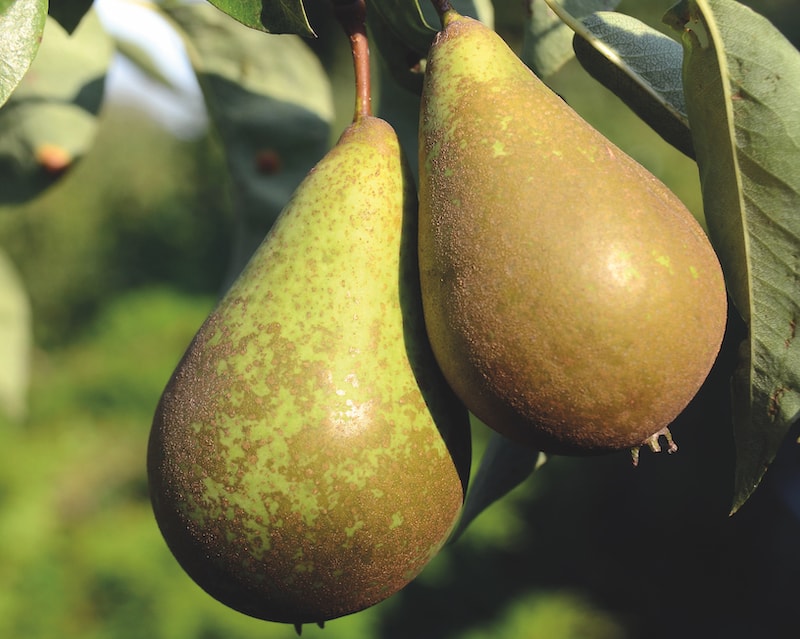
Image: Pear ‘Doyenne du Comice’ from Suttons
Instagrammer @hettysgarden prefers to pick her pears underripe and then “ripen them inside, rather than let the wasps start getting busy!” Take a look at her post about picking pears to see the bumper crop she grew this summer. This blogger is on a mission to explore “organic, no-dig permaculture gardening for well-being, sustainability, and better food.” Follow her journey on Instagram for inspiration.
Charles Dowding’s video on growing fruit trees in a temperate climate is hugely informative, discussing rootstocks, pruning and thinning. His top tip for knowing when to pick your pears? Lift the fruit 90° from the branch – “if it stays on the tree, leave it on.” Once the fruit has been harvested, bring it indoors and allow it time to soften and sweeten before eating.
This year’s heatwave and drought caused lots of pears to drop early, “meaning we returned from holiday to a lawn covered in hundreds of tiny, spoiled pears,” said Instagram gardener @_straight.outta.compost_. Luckily they were still able to harvest a good amount of fruit from their single tree. Do you have any helpful recipe suggestions? They’d welcome your ideas for their haul of pears – “preferably not requiring peeling!”
Over at @plotandpantry, Penny Foxwell harvests her pears before they’ve fully ripened to stop the crows from stealing them: “They literally carry whole pears into the field and snack on them.” She then preserves the pears by bottling them in a light syrup. In this way, the fruit “will last at least a year and look gorgeous on your pantry shelves.”
With so many pear varieties and growing options to choose from, it has never been a better time to grow your own pear tree. Whether you’re planting on an allotment or in a patio container at home, growing your own pears is hugely rewarding.
Lead image: Pear ‘Williams’ Bon Chretien’ from Suttons
Last Updated on September 30, 2024 by Suttons Horticultural Team

